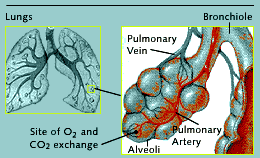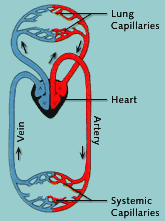 |
How the Body Uses O2
A version of this article first appeared on NOVA's Web site Everest.
We depend on air for our survival. More specifically, we depend on oxygen.
Without it, we would die. But with it, we thrive. Enough oxygen must reach
the tiny cells throughout our body to feed them, giving them the energy
necessary for life. As the NOVA mountaineers climb ever higher up Mt. McKinley,
their bodies must try to get enough oxygen to their cells, despite the thin air
at extreme altitude. But sometimes, no matter how fit the body, it falls
victim to the effects of low oxygen -- fatigue, hyperventilation, fainting, or
worse.
The general process of breathing can be described in several essential steps:
- Air enters the lungs as muscles expand the chest outward; by opening up
your chest, the atmospheric pressure rushes air in to fill this space.
Muscles contracting then force this air back out. It is a simple, elegant, and
essential process for moving oxygen into the body.
- As air rushes down into the lungs, it is warmed, moistened, and cleaned by
the upper airways. For a climber this process is essential. The colder and
dryer the air, the more energy and moisture that is needed to warm it.

- The air travels down the large trachea into the lungs. Here it continues
through smaller and smaller tube-like structures called bronchioles, until it
reaches the tiniest air sacs, named alveoli. At this point tiny blood vessels,
known as capillaries, carry the blood past the alveoli, which replenish it with
new oxygen. As climbers go higher and the pressure of air changes, the
efficiency of this exchange is affected.
- Oxygen is carried by hemoglobin in the red blood cells. These amazing
"carriers" of oxygen become more efficient when less oxygen is available,
helping us adapt. Altitudes of up to 6,000 feet can go unnoticed in the
average person. But after this, the body can have a more difficult time
getting enough oxygen to the cells.
- Oxygenated blood rushes from the capillaries in the lungs through larger
and larger blood vessels until it returns to the left side
of the heart and is pumped throughout
the body.
- Large and small arteries provide a network to deliver the oxygenated blood to
the cells. At critical points, these arteries break into increasingly smaller
 branches until they reach the capillaries, where the oxygen is fed to the
individual cells.
branches until they reach the capillaries, where the oxygen is fed to the
individual cells.
- The energy station of the cells, called mitochondria, process oxygen to
power the cells. As part of the combustion process, carbon dioxide is
released. At different levels of exertion and oxygen pressures, the amount of
carbon dioxide in the blood can change. Too much carbon dioxide will stimulate
the body to breathe, just as a lack of oxygen does the same. An unhealthy
balance will cause the symptoms of altitude sickness.
- Through this labyrinth of blood vessels, now called veins, the hemoglobin
returns carbon dioxide through the heart and to the lungs. Carbon dioxide is
released back out as you exhale, and the process starts all over again.
Everywhere on earth, oxygen makes up 20.96% of the gas in air (almost all the
rest is nitrogen). The atmospheric pressure helps determine just how
dense this air is, and therefore what concentration of oxygen the air contains.
At 18,000 feet, atmospheric pressure is half what it is at sea level. The
pressure of oxygen is therefore also half. As people climb from sea level to
these heights, their bodies -- and breathing -- must adapt to the changing
concentrations of oxygen in the air.
Changes in the concentration of oxygen affect the way the body breathes. It's
critical that climbers regulate their breathing to maintain an appropriate
level of oxygen in the blood. If this fails, the only recourse is to descend.
The necessary level of oxygen in the blood can vary from person to person,
depending on their body's ability to compensate and acclimatize to low oxygen.
The climbers have been measuring the oxygen saturation in their blood through
the course of the NOVA expedition to help scientists better understand how the
body responds to these changes in oxygen pressure.
Climb |
Expedition |
Mountain of Extremes
Denali for Kids |
Dispatches |
E-Mail |
Resources
Site Map |
Surviving Denali Home
Editor's Picks |
Previous Sites |
Join Us/E-mail |
TV/Web Schedule
About NOVA |
Teachers |
Site Map |
Shop |
Jobs |
Search |
To print
PBS Online |
NOVA Online |
WGBH
© | Updated November 2000
|


